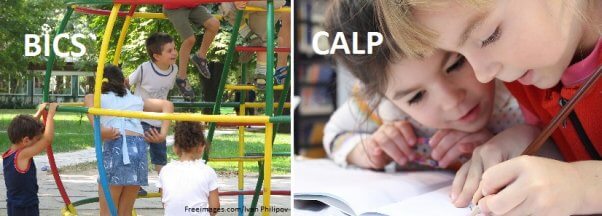Language Learning Through Humane Education (ESL)
Compassion for Animals by Any Other Name
Research tells us that literacy skills acquired while mastering your first language can be transferred to another one. So if children express their love for animals in one language, they only need to learn the vocabulary for that expression of caring in the new one. A child’s affinity for animals transcends language.

Humane Education Can Help English Language Learners Connect Social and Academic Languages
There’s social language, and there’s academic language. English Language Learners (ELLs) develop social language skills faster than academic language abilities—and it’s the social language competence that you typically see displayed on the playground and with friends. Academic language proficiency is more difficult to attain.
BICS (Basic Interpersonal Communication Skills) and CALP (Cognitive Academic Language Proficiency) are famous acronyms coined by professor and researcher Jim Cummins—who has made major contributions to the field of second language acquisition. These terms are commonly discussed among teachers of ELLs and refer to language skills that are needed to accomplish various leveled tasks on a language acquisition continuum, from context embedded situations to those that are more cognitively demanding.

BICS—social (everyday, face-to-face) interactions—are usually context embedded and, according to Cummins, ELLs typically develop these skills within six months to two years. Because of their natural interest in animals, it’s not surprising to see newcomer ELLs demonstrate prowess in talking about their animal companion at home, their favorite animal, or another animal they’re excited about. This is BICS.
CALP refers to a student’s ability to handle the academic demands of language in grade-level content areas. Cummins suggests that it may take at least five years for an ELL to achieve language proficiency that’s on a par with that of native speakers in more cognitively demanding and context-reduced activities.
Since kids love animals and are also motivated to learn how to express their feelings about them, we can use this inclination to help bridge the divide between BICS and CALP for ELLs. When students hear that animals need our help, they want to learn more and do something to assist. We can engage them in more cognitively demanding activities about animals that integrate all linguistic skills (reading, writing, listening, and speaking) and that require more sustained effort and motivation. This can also encourage ELLs to take charge of their own learning by searching out additional resources (for example, books, videos, and websites) that help them make meaning of the content. This is an authentic way to inspire them to work hard at communicating a clear message verbally or in writing. Reminding them that the message to help animals must be clear or it may not be understood will encourage students to keep at it.

Support Language Learning Through Compassion for Animals
ELLs may be accustomed to expressing information about animals only via social language in English, but now, you can help them take this expression to a new academic level—one that has real-world applications. You can foster language proficiency by tapping into their interest in animals.
You’ll want to start with activating prior knowledge about particular types of animals by asking ELLs to describe experiences that they’ve had with them—and allowing them to express themselves in either their native language or English. Learning about the plight of animals will motivate many to want to take action. Let students know that a good way to help animals is by learning more about the issues related to them and ways in which they can help. Then they can do something important by communicating the message regarding how to help animals to others—this will help them develop their linguistic skills in all modalities (listening, speaking, reading, and writing).
Here are examples of specific activities that you can incorporate into your curriculum to address an animal issue, foster empathy, and connect social and academic languages:
Listening/Reading
Explain that while many dogs are treated as family members in the U.S. (as they should be), many others need our help. Right now, countless dogs are chained outdoors in all weather conditions, languishing alone and struggling to survive long days and nights without proper shelter from the elements. Often, these lonely animals are deprived of even basic necessities—such as food, water, and veterinary care. They’re forced to spend their lives in solitary confinement, relegated to the backyard without any companionship, play, or exercise. You can use these before and after photos to give ELLs visual support. A key vocabulary word to go over with them is “chain” (used to restrict dogs’ movement). And it would be helpful to explain to them how PETA helps “backyard dogs.”

Have your elementary students learn more about this issue by reading the comic book “A Dog’s Life,” which tells the story of a dog who was rescued from life on a chain. (A free class set can be ordered from TeachKind.) Your students can also listen to the read-aloud below as they follow along with the comic book. Older students can read “A Day in the Life of a PETA Fieldworker.”
Comprehensible input is important for language acquisition, so efforts should be made to make the content understandable through a variety of means. Some ways to make these texts accessible to ELLs at all proficiency levels include reading them aloud and asking leveled comprehension questions during the reading, having students read with a partner, or having them listen to a recording of the texts. See this lesson for more activities that can provide ELLs with multiple exposures to this topic for all grade levels in order to promote a greater understanding of the content. (It includes a video, a main idea graphic organizer, and another graphic organizer on the author’s purpose.) You could also invite someone from your local shelter to speak about the issue of “backyard dogs.” Staffers from PETA’s youth division are also available to give an age-appropriate Skype presentation to your class on any animal-related issue—request a speaker here.
Speaking/Writing
An option for developing the speaking modality is to have students discuss their responses to any or all of the following questions in a small group. (You can create heterogeneous groups by including students with different language proficiency levels in each one.) You can also have someone from each group summarize the responses to the questions and share them with the whole class:
- Why do some people keep their dogs chained outside instead of keeping them indoors with their families?
- What are three sad or difficult things that dogs experience when they’re chained outside?
- Should there be consequences for people who don’t provide the animals they’re responsible for with adequate care? Explain your answer.
- What would you do if you saw that people were keeping a dog chained outside?

This topic will most likely provoke strong opinions about the way in which animals and others should be treated, so it can be a springboard for opinion writing. Have students use this writing prompt to create an opinion piece: “Do you think that it’s ever OK to keep a dog chained outdoors? Why or why not?” You can allow ELLs to express their opinions about this issue in a variety of ways, including through drawings and in their native language.
Discussing animal rights issues (for example, animal companions, wildlife, animals used for food, animals used for clothing, animals used for entertainment, and animals used for experimentation) with ELLs provides them with many opportunities to build oral language fluency. Sometimes, students become so passionate about an issue that their determination to spread the message of compassion for animals overrides any anxiety that they may feel when speaking in their new language.
The possibilities are endless. After you explore additional animal rights issues with ELL students, you can have them write a speech to let others know how difficult life is for animals in circuses and what humans can do to help them. A higher-order thinking activity would be having students create dialog for a dramatic representation concerning how animals living on factory farms feel. These kinds of tasks help ELLs develop skills in reading, writing, listening, and speaking in an integrated manner.
Meaningful activities that help ELLs learn about the reality of what’s happening to animals in our world and how to help them—and that empower students to take action—are great ways to move ELLs past social language and set them on a path to mastering academic language in English.
Does TeachKind offer any resources for ELLs?
TeachKind has got you covered:
- Our free Share the World kit is perfect for teaching ELL students at the elementary-school level about the Golden Rule and the importance of compassion and empathy—as well as reading and writing skills. It includes an inspiring video about animals and extra visual supports.
xxx
 xxx
xxx
xxx
xxx - Our free Humane Lesson Webinar provides you with a step-by-step guide regarding how to create a humane lesson. And it includes scaffolding strategies that are appropriate for ELLs.
xxx
 xxx
xxx - Our free lessons and activities give you the resources that you need to incorporate compassion for animals into your curriculum, and they’re ELL-friendly. xxx
- Order free TeachKind materials for your classroom. We have engaging resources that help ELLs activate prior knowledge and make new connections. xxx
- Contact TeachKind for suggestions or advice regarding how to incorporate humane education into the curriculum for ELL students.
Like these ideas? Please share them to inspire other teachers of ELLs to incorporate compassion for animals into their curriculum in order to foster English language proficiency.
Need more classroom inspiration? Fill out the form below to sign up for TeachKind News.
By submitting this form, you’re acknowledging that you have read and agree to our privacy policy and agree to receive e-mails from us.
Written by Lisbet Chiriboga (Ms. Chiriboga is a licensed bilingual and TESOL teacher and taught ELLs for over a decade.)





